What is the Cavity Within the Kidney That is Continuous With the Ureter
19.4: Ureters, Urinary Bladder, and Urethra
- Page ID
- 16841
Why do dogs urinate on fire hydrants? Besides "having to go," they are marking their territory with chemicals called pheromones in their urine. It's a form of communication, in which they are "saying" with odors that the yard is theirs and other dogs should stay away. Dogs may urinate on fence posts, trees, car tires, and many other objects in addition to fire hydrants. Urination in dogs, as in people, is usually a voluntary process controlled by the brain. The process of forming urine, which occurs in the kidneys, occurs constantly and is not under voluntary control. What happens to all the urine that forms in the kidneys? It passes from the kidneys through the other organs of the urinary system, starting with the ureters.
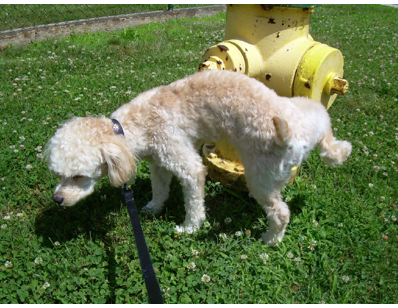
Ureters
As shown in Figure \(\PageIndex{2}\), ureters are tube-like structures that connect the kidneys with the urinary bladder. They are paired structures, with one ureter for each kidney. In adults, ureters are between 25 and 30 cm (10 to 12 in.) long and about 3 to 4 mm (about 1/8 in.) in diameter.

Each ureter arises in the pelvis of a kidney (Figure \(\PageIndex{3}\)). It then passes down the side of the kidney and finally enters the back of the bladder.
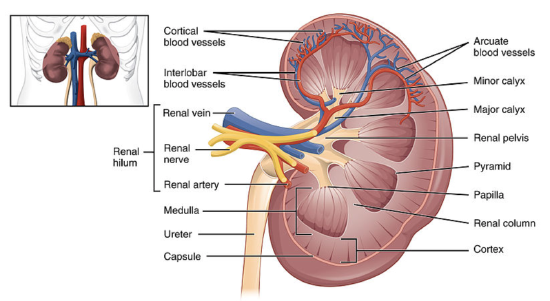
The walls of the ureters are composed of multiple layers of different types of tissues. You can see the layers in Figure \(\PageIndex{4}\). The innermost layer is a special type of epithelium, called the transitional epithelium. Unlike the epithelium lining most organs, the transitional epithelium is capable of flattening and distending and does not produce mucus. It lines much of the urinary system, including the renal pelvis, bladder, and much of the urethra in addition to the ureters. Transitional epithelium allows these organs to stretch and expand as they fill with urine or allow urine to pass through. The next layer of the ureter walls is made up of loose connective tissue containing elastic fibers, nerves, and blood and lymphatic vessels. After this layer are two layers of smooth muscles, an inner circular layer, and an outer longitudinal layer. The smooth muscle layers can contract in waves of peristalsis to propel urine down the ureters from the kidneys to the urinary bladder. The outermost layer of the ureter walls consists of fibrous tissue.
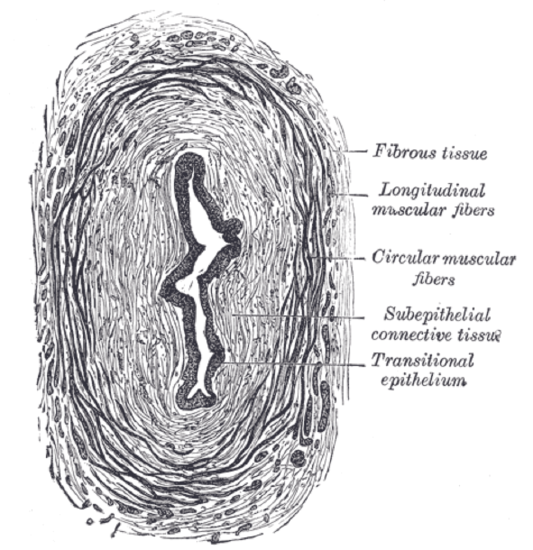
Urinary Bladder
The urinary bladder is a hollow, muscular, and stretchy organ that rests on the pelvic floor. It collects and stores urine from the kidneys before the urine is eliminated through urination. As shown in Figure \(\PageIndex{5}\), urine enters the urinary bladder from the ureters through two ureteral openings on either side of the back wall of the bladder. Urine leaves the bladder through a sphincter called the internal urethral sphincter. When the sphincter relaxes and opens, it allows urine to flow out of the bladder and into the urethra.
Like the ureters, the bladder is lined with transitional epithelium, which can flatten out and stretch as needed as the bladder fills with urine. The next layer (lamina propria) is a layer of loose connective tissue, nerves, and blood and lymphatic vessels. This is followed by a submucosa layer, which connects the lining of the bladder with the detrusor muscle in the walls of the bladder. The outer covering of the bladder is the peritoneum, which is a smooth layer of epithelial cells that lines the abdominal cavity and covers most abdominal organs.
The detrusor muscle in the wall of the bladder is made of smooth muscle fibers that are controlled by both the autonomic and somatic nervous systems. As the bladder fills, the detrusor muscle automatically relaxes to allow it to hold more urine. When the bladder is about half full, the stretching of the walls triggers the sensation of needing to urinate. When the individual is ready to void, conscious nervous signals cause the detrusor muscle to contract and the internal urethral sphincter to relax and open. As a result, urine is forcefully expelled out of the bladder and into the urethra.
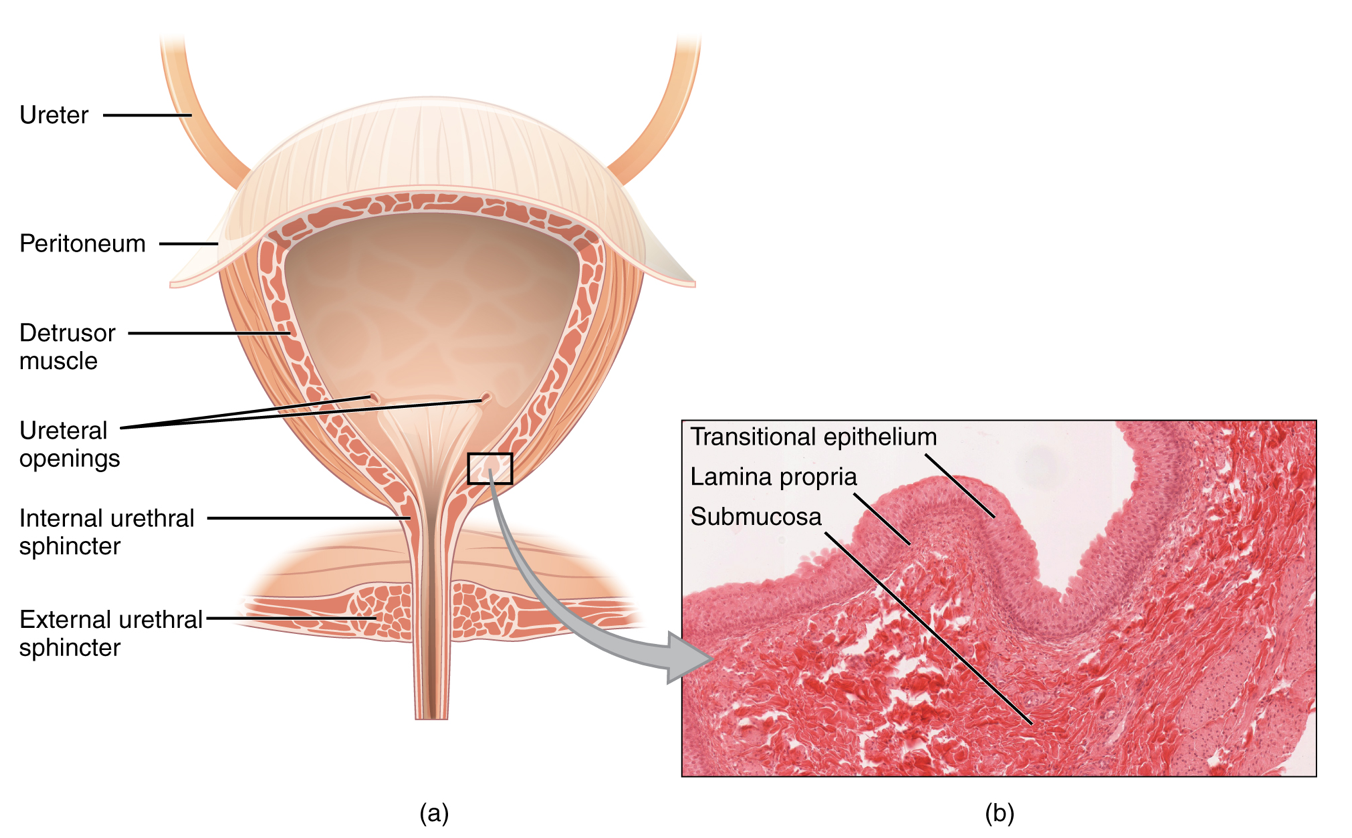
Urethra
The urethra is a tube that connects the urinary bladder to the external urethral orifice, which is the opening of the urethra on the surface of the body. As shown in Figure \(\PageIndex{6}\), the urethra in a person with XY chromosomes (anatomically male) travels through the penis, so it is much longer than the urethra in a person with XX chromosomes (anatomically female). In a genetically male person, the urethra averages about 20 cm (8 in.) long, whereas, in a genetically female individual, it averages only about 4.8 cm (1.9 in.) long. In an XY individual, the urethra carries semen as well as urine, but in the XX individual, it carries only urine.
Like the ureters and bladder, the proximal (closer to the bladder) two-thirds of the urethra are lined with transitional epithelium. The distal (farther from the bladder) third of the urethra is lined with mucus-secreting epithelium. The mucus helps protect the epithelium from urine, which is corrosive. Below the epithelium is loose connective tissue, and below that are layers of smooth muscle that are continuous with the muscle layers of the urinary bladder. When the bladder contracts to forcefully expel urine, the smooth muscle of the urethra relaxes to allow the urine to pass through.
In order for urine to leave the body through the external urethral orifice, the external urethral sphincter must relax and open. This sphincter is a striated muscle that is controlled by the somatic nervous system, so it is under conscious, voluntary control in most people (exceptions are infants, some elderly people, and patients with certain injuries or disorders). The muscle can be held in a contracted state and hold in the urine until the person is ready to urinate. Following urination, the smooth muscle lining the urethra automatically contracts to re-establish muscle tone, and the individual consciously contracts the external urethral sphincter to close the external urethral opening.
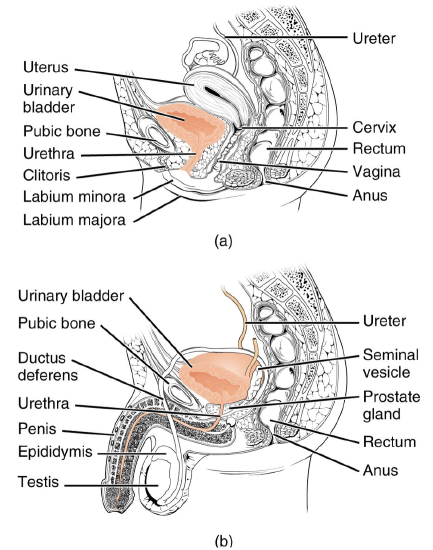
Review
- What are ureters?
- Describe the location of the ureters relative to other urinary tract organs.
- Identify layers in the walls of a ureter and how they contribute to the ureter's function.
- Describe the urinary bladder.
- What is the function of the urinary bladder?
- How does the nervous system control the urinary bladder?
- What is the urethra?
- How does the nervous system control urination?
- Identify the sphincters that are located along the pathway from the ureters to the external urethral orifice.
- What are two differences between the male and female urethra?
- True or False. Urine travels through the urinary system due solely to the force of gravity.
- True or False. Urination refers to the process that occurs from the formation of urine in the kidneys to the elimination of urine from the body.
- When the bladder muscle contracts, the smooth muscle in the walls of the urethra _________ .
- Transitional epithelium lines the:
A. bladder
B. ureters
C. renal pelvis
D. All of the above
Explore More
Source: https://bio.libretexts.org/Bookshelves/Human_Biology/Book%3A_Human_Biology_(Wakim_and_Grewal)/19%3A_Urinary_System/19.4%3A_Ureters_Urinary_Bladder_and_Urethra
0 Response to "What is the Cavity Within the Kidney That is Continuous With the Ureter"
Post a Comment